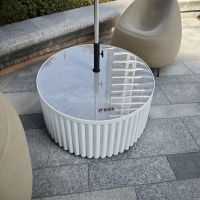Welcome to the website for landscape facilities products and knowledge.
What are the key differences between metal, wood, and plastic landscape chairs in terms of performance and aesthetics?
When selecting landscape chairs for outdoor spaces, the choice between metal, wood, and plastic materials significantly impacts both performance and aesthetics. Each material offers unique advantages and drawbacks, making it essential to understand their differences before making a decision.
Performance:
1. Metal Chairs: Known for their durability and strength, metal chairs (e.g., aluminum or wrought iron) resist weathering and heavy use. However, they can become uncomfortably hot in direct sunlight and may rust if not properly treated.
2. Wood Chairs: Wooden chairs, such as teak or cedar, provide natural warmth and sturdiness. They require regular maintenance like sealing or staining to prevent rot and insect damage but age beautifully over time.
3. Plastic Chairs: Lightweight and low-maintenance, plastic chairs are resistant to moisture and fading. However, they lack the structural integrity of metal or wood and may crack under extreme temperatures.
Aesthetics:
- Metal: Offers a sleek, modern look, ideal for contemporary landscapes. Available in various finishes, from polished to rustic.
- Wood: Brings a timeless, organic feel, perfect for traditional or rustic settings. The grain and color variations add natural charm.
- Plastic: Comes in vibrant colors and minimalist designs, suitable for casual or playful outdoor spaces but often perceived as less premium.
Ultimately, the best choice depends on your climate, maintenance willingness, and design preferences. Metal excels in durability, wood in classic appeal, and plastic in affordability and ease of care.
Related search:

Recommendation
Round metal tube border design table with tempered glass or granite countertop on the top.